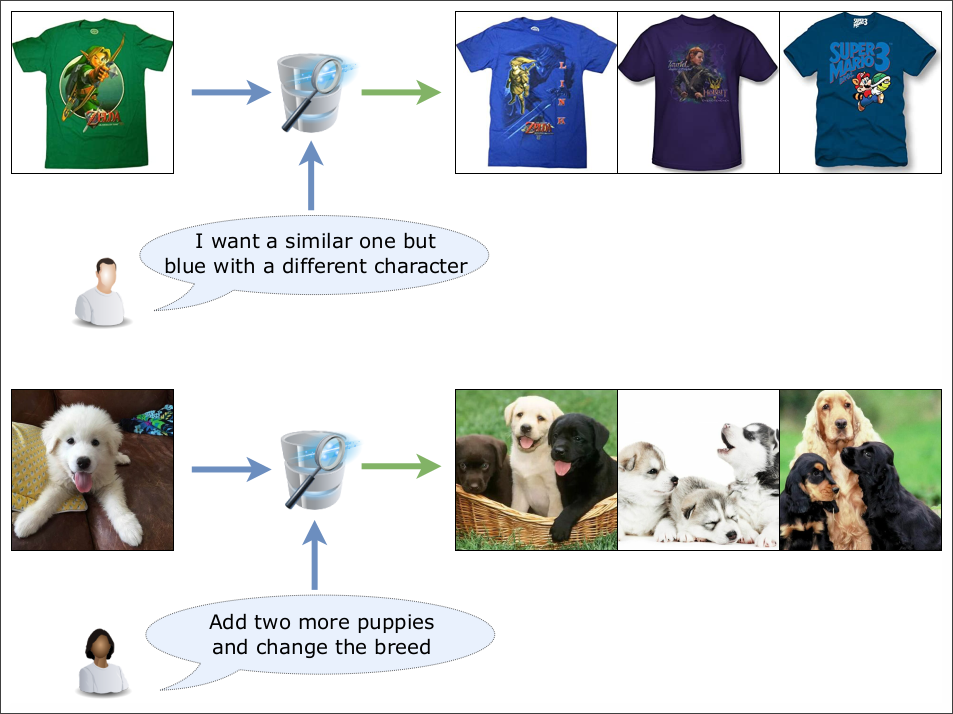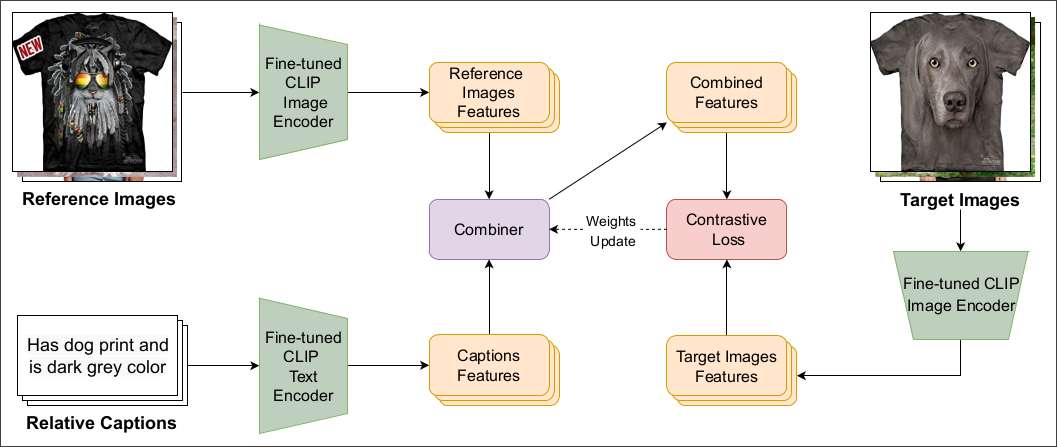Recent works have shown that large-scale vision and language pretrained (VLP) models can address many different tasks, such as zero-shot learning or text-to-image retrieval. In this paper, we address the task of composed image retrieval. In this recently introduced task, the query is provided as an image-text pair. Multi-modal content-based image retrieval is performed starting with a reference image and an additional text that describes in natural language conditions or changes with respect to the reference image, about the output images to be retrieved.
To address this task, we explore the use of features obtained from the OpenAI CLIP model, and we initially perform a task-oriented fine-tuning of both CLIP encoders using a combination of visual and textual features. Then, in the second stage, we learn a Combiner network that can merge the fine-tuned features integrating the multimodal information and providing combined features used to perform the retrieval task. Contrastive learning is used in the training of both stages.
Starting from the bare CLIP features as a baseline, we show that both the task-oriented fine-tuning and the carefully crafted Combiner network are highly effective and outperform more complex state-of-the-art approaches on FashionIQ and CIRR, two popular and challenging datasets for composed image retrieval
To get a local copy up and running follow these simple steps.
We strongly recommend the use of the Anaconda package manager to avoid dependency/reproducibility problems. A conda installation guide for Linux systems can be found here
- Clone the repo
git clone https://github.com/ABaldrati/CLIP4Cir- Install Python dependencies
conda create -n clip4cir -y python=3.8
conda activate clip4cir
conda install -y -c pytorch pytorch=1.11.0 torchvision=0.12.0
conda install -y -c anaconda pandas=1.4.2
pip install comet-ml==3.21.0
pip install git+https://github.com/openai/CLIP.gitHere's a brief description of each file under the src/ directory:
For running the following scripts in a decent amount of time, it is heavily recommended to use a CUDA-capable GPU. It is also recommended to have a properly initialized Comet.ml account to have better logging of the metrics (all the metrics will also be logged on a csv file).
utils.py: utils filecombiner.py: Combiner model definitiondata_utils.py: dataset loading and preprocessing utilsclip_fine_tune.py: CLIP task-oriented fine-tuning filecombiner_train.py: Combiner training filevalidate.py: compute metrics on the validation setscirr_test_submission.py: generate test prediction on cirr test set
N.B The purpose of the code in this repo is to be as clear as possible. For this reason, it does not include some optimizations such as gradient checkpointing (when fine-tuning CLIP) and feature pre-computation (when training the Combiner network)
To properly work with the codebase FashionIQ and CIRR datasets should have the following structure:
project_base_path
└─── fashionIQ_dataset
└─── captions
| cap.dress.test.json
| cap.dress.train.json
| cap.dress.val.json
| ...
└─── images
| B00006M009.jpg
| B00006M00B.jpg
| B00006M6IH.jpg
| ...
└─── image_splits
| split.dress.test.json
| split.dress.train.json
| split.dress.val.json
| ...
└─── cirr_dataset
└─── train
└─── 0
| train-10108-0-img0.png
| train-10108-0-img1.png
| train-10108-1-img0.png
| ...
└─── 1
| train-10056-0-img0.png
| train-10056-0-img1.png
| train-10056-1-img0.png
| ...
...
└─── dev
| dev-0-0-img0.png
| dev-0-0-img1.png
| dev-0-1-img0.png
| ...
└─── test1
| test1-0-0-img0.png
| test1-0-0-img1.png
| test1-0-1-img0.png
| ...
└─── cirr
└─── captions
| cap.rc2.test1.json
| cap.rc2.train.json
| cap.rc2.val.json
└─── image_splits
| split.rc2.test1.json
| split.rc2.train.json
| split.rc2.val.json
We provide the pre-trained (both CLIP and Combiner network) checkpoint via Google Drive in case you don't have enough GPU resources
To fine-tune the CLIP model on FashionIQ or CIRR dataset run the following command with the desired hyper-parameters:
python src/clip_fine_tune.py --dataset {'CIRR' or 'FashionIQ'} --api-key {Comet-api-key} --workspace {Comet-workspace} --experiment-name {Comet-experiment-name} --num-epochs 100 --clip-model-name RN50x4 --encoder both --learning-rate 2e-6 --batch-size 128 --transform targetpad --target-ratio 1.25 --save-training --save-best --validation-frequency 1To train the Combiner model on FashionIQ or CIRR dataset run the following command with the desired hyper-parameters:
python src/combiner_train.py --dataset {'CIRR' or 'FashionIQ'} --api-key {Comet-api-key} --workspace {Comet-workspace} --experiment-name {Comet-experiment-name} --projection-dim 2560 --hidden-dim 5120 --num-epochs 300 --clip-model-name RN50x4 --clip-model-path {path-to-fine-tuned-CLIP} --combiner-lr 2e-5 --batch-size 4096 --clip-bs 32 --transform targetpad --target-ratio 1.25 --save-training --save-best --validation-frequency 1To compute the metrics on the validation set run the following command
python src/validate.py --dataset {'CIRR' or 'FashionIQ'} --combining-function {'combiner' or 'sum'} --combiner-path {path to trained Combiner} --projection-dim 2560 --hidden-dim 5120 --clip-model-name RN50x4 --clip-model-path {path-to-fine-tuned-CLIP} --target-ratio 1.25 --transform targetpadTo generate the prediction files to be submitted on CIRR evaluation server run the following command:
python src/cirr_test_submission.py --submission-name {file name of the submission} --combining-function {'combiner' or 'sum'} --combiner-path {path to trained Combiner} --projection-dim 4096 --hidden-dim 8192 --clip-model-name RN50x4 --clip-model-path {path-to-fine-tuned-CLIP} --target-ratio 1.25 --transform targetpadWe gratefully acknowledge the support of NVIDIA Corporation with the donation of the Titan X Pascal GPU used for this research. This work was partially supported by the European Commission under European Horizon 2020 Programme, grant number 101004545 - ReInHerit.



